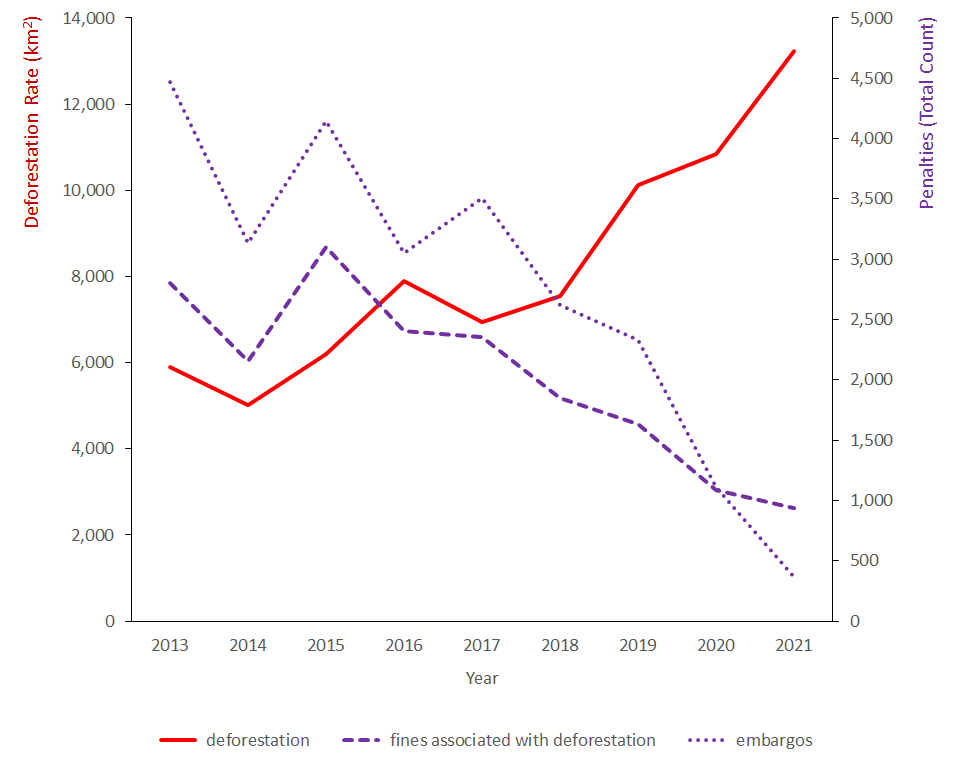Law enforcement is crucial for Amazon conservation and sustainable development. Governmental inaction favors those who break the law. As enforcement plummeted, deforestation soared.
Let there be no room for doubt: it is impossible to fight Amazon deforestation without public authorities’ commitment to combating illegality in the region. This isn’t a novel idea, but it needs to be explicitly stated at times of unrelenting attacks against Brazil’s capacity to enforce its environmental laws. Attacks come in several shapes and sizes: a president who applauds the blatant weakening of law enforcement, environmental police helicopters that are burned upon request of a businessman thirsty for retaliation, public servants who are institutionally prevented from investigating and punishing illicit practices… It’s a long and infuriating list.
Some people frown upon the idea that environmental control must be the foundation of a robust strategy for conservation and sustainable development in the Amazon. After all, there are so many efforts beyond monitoring and law enforcement that aim at fighting deforestation, right? Yes, many of these efforts do help. However, effective environmental control is currently the most critical factor for protecting our forests.
Effective environmental control is currently the most critical factor for protecting our forests.
To understand why, we must start by recalling that virtually all Amazon deforestation is illegal. MapBiomas Alerta estimates that over 99% of deforestation alerts issued in the biome in 2020 contained signs of illegality. The numbers for 2021 are not yet available, but there is no reason to expect significantly different results, given the patterns historically observed in the region. If dealing with an illegal activity, there is room for law enforcement.
This is where environmental control comes in. I recently wrote about how satellite monitoring brought unprecedented scale and speed to the detection of Amazon forest loss. Today, I’ll focus on compliance with environmental laws. Simply put, the most common (albeit not the only) process for pursuing this entails field operations to investigate suspected illegal deforestation. When law enforcement authorities detect an offense and identify those responsible for it, they punish offenders. Fines, embargos, and seizure and destruction of machinery are examples of administrative penalties typically associated with deforestation, but environmental offenders can also be charged under civil and criminal laws.
Although the many types of penalties differ amongst themselves, they all share what is essentially an economic goal: to increase the cost of illegal deforestation. The reasoning is quite simple, a cost-benefit calculation. To decide whether to clear a given area, a potential offender compares what they expect to win and to lose with that decision.
Expected gains encompass payment for carrying out deforestation commissioned by a third party, revenue from the sale of high-value timber, profits from selling the land many years later, or any other benefit that derives from that clearing. Expected losses include expenses incurred for taking down the forest, but mostly the risk of getting caught, held accountable, and punished for deforestation. The stricter the punishment, the greater the expected loss.
It seems pretty obvious and, in many ways, it is. If deforestation becomes more costly — because it may lead to hefty fines, restricted access to financial resources due to embargos, loss of expensive machinery, high legal fees, fleeing investors, and so forth — it becomes less appealing.
The key to this story is the use of the term expected cost. Each of these penalties is associated with a probability in the cost-benefit calculation. If a potential offender believes there is a small chance that they will be caught and punished, they will assign a small weight to penalties. In a context of known impunity, all penalties have null weights, so deforestation becomes an activity that carries zero risk and zero cost. In this case, deforesting really does pay off.
Anything that affects the perception of risk matters. Public officials who demoralize environmental law enforcement, the dismantling of institutional enforcement capacities, the sustained tolerance of illegality in the Amazon… It all sends one clear message: those who break the law will not be punished. From that point on, illegality is bound to escalate and to do so quickly.
In light of this, the trajectories shown below become even more alarming. While deforestation increased, environmental fines and embargos issued by the federal law enforcement authority plummeted in the Amazon. While these are not the only relevant metrics for tracking environmental control, they are telling. Governmental inaction favors those who break the law and encourages others to do the same, further aggravating the scenario.
Rising deforestation and plummeting administrative penalties

The main role of environmental control is to avoid illegality. Punishment is a means to this end, a way of signaling to society that the government will act to enforce the laws and that breaking them is not advantageous.
This is why I again stress that environmental control is the foundation of a robust strategy for conservation and sustainable development. Ensuring compliance with the law is not only a necessary condition for combating illegality, but also for allowing that many other measures for forest protection can thrive. After all, without laws, how can territorial protection be implemented, property rights respected, sustainable supply chains strengthened, contracts fulfilled?
Brazil knows that monitoring and law enforcement are effective and essential for fighting Amazon deforestation. This was true 20 years ago, and it still is true today. I hope this changes, and I work hard for it. By strengthening compliance with the law in the Amazon, we will be able to move the discussion towards a broader and more nuanced menu of conservation mechanisms. But we’re not at that stage yet, and we will not get there unless we acknowledge that law enforcement is the cornerstone for everything else.
The opinions expressed in this article are the writer’s own.



